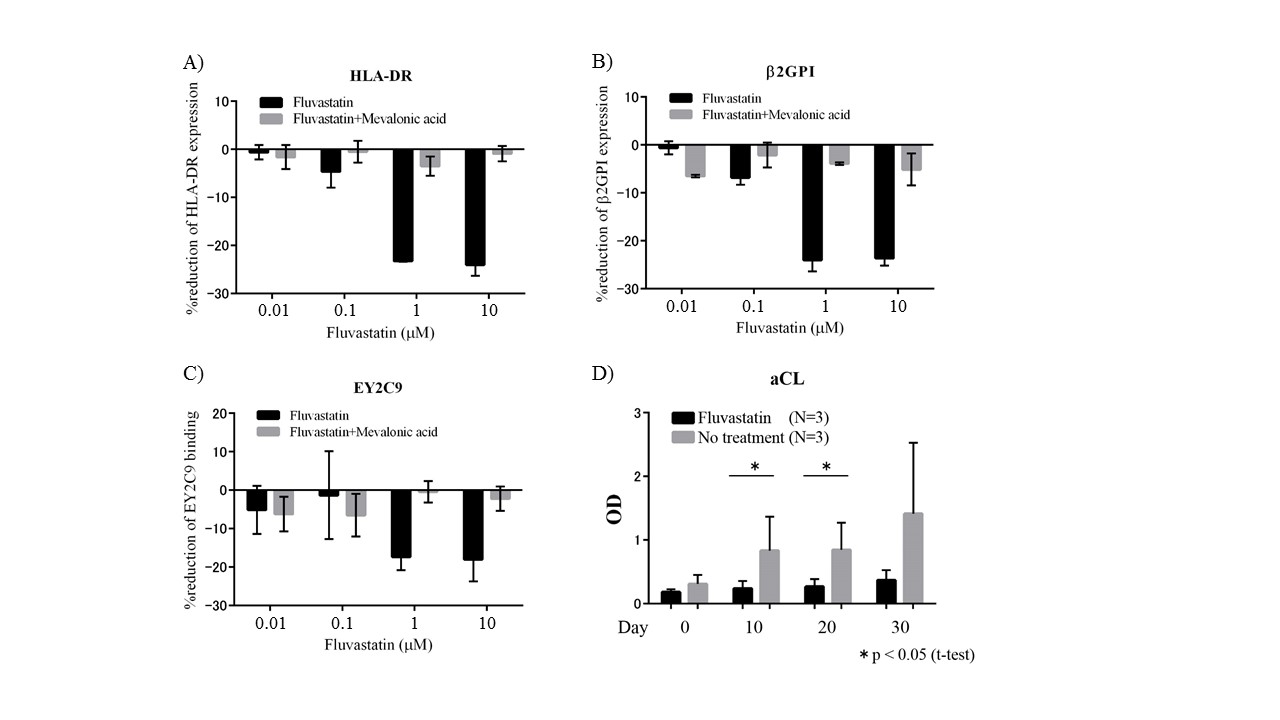Session Information
Session Type: ACR Concurrent Abstract Session
Session Time: 2:30PM-4:00PM
Background/Purpose:
Human leukocyte antigen (HLA)-DRB1*07:01 is one of the susceptibility
alleles for antiphospholipid syndrome (APS). Recently we have reported
that beta-2-glycoprotein I (b2GPI) /HLA class II complex is targeted by anti-b2GPI
antibody. The 3-hydroxy-3-methyl-glutaryl-CoA reductase inhibitors
(statins) reduce procoagulant cell activation by anti-b2GPI antibody, thus having
potential benefit for patients with APS, although the mechanisms have not been
clarified. The aim of this study was to identify the mechanisms involved
in the reduction of anti-b2GPI antibody induced procoagulant activity by statins.
Methods: b2GPI was co-transfected
into immortalized human umbilical vein endothelial cell (HUEhT-1) and human
monocytic cell line (THP-1), together with HLA-DRA*01:01/DRB1*07:01 (HLA-DR7)
or HLA-DRA*01:01/DRB1*08:01 (HLA-DR8). Fluvastatin was added to cells in
the presence or absence of mevalonic acid. The expression of HLA-DR and b2GPI on the cell
surfaces was assessed by flowcytometry (FCM). The binding ability of
human monoclonal anti-b2GPI antibody (EY2C9) to these cells was analyzed by FCM. In
an in vivo study using env-pX rats, as a spontaneous rat model of APS,
fluvastatin (200 mg/day) was administered orally for 30 days. The titer of
anti-cardiolipin/b2GPI complex (aCL) was sequentially determined every 10 days.
Results: Both the expression of b2GPI and binding
of EY2C9 were more highly observed on the surface of HUEhT-1 and THP-1
co-transfected with HLA-DR7 than HLA-DR8. The expression of b2GPI was not
detected on the surface of cells transfected with b2GPI alone. In
HUEhT-1 co-transfected with b2GPI and HLA-DR7, the addition of fluvastatin suppressed the
expression of HLA-DR, as well as the expression of b2GPI presented on HLA-DR
(Figure 1A and 1B). This inhibitory effect was reduced by mevalonic acid.
In addition, the EY2C9 binding to HUEhT-1 was reduced by fluvastatin
(Figure 1C). Similar results were obtained in THP-1 transfected with b2GPI and
HLA-DR7. In the rat model experiment, the administration of fluvastatin
to env-pX significantly reduced the titer of aCL (Figure 1D)
Conclusion: Fluvastatin inhibited the
expression of b2GPI/HLA class II complex, leading to down regulation of anti-b2GPI antibody
binding. The aCL titer in env-pX rats was reduced by fluvastatin as well.
The inhibition of the pathogenic autoantigen presentation through the
reduction of HLA-DR expression might be one of the mechanisms involved in the
deprocoagulating effects of statins.
To cite this abstract in AMA style:
Watanabe T, Oku K, Amengual O, Hisada R, Ohmura K, Shida H, Shimizu Y, Kato M, Bohgaki T, Horita T, Yasuda S, Ishizu A, Arase H, Atsumi T. Reduction of HLA Class II Expression and Beta-2-Glycoprotein I Presentation By Fluvastatin in Vitro and in Vivo: Possible Mechanism of Statin-Induced-Deprocoagulation in the Antiphospholipid Syndrome [abstract]. Arthritis Rheumatol. 2015; 67 (suppl 10). https://acrabstracts.org/abstract/reduction-of-hla-class-ii-expression-and-beta-2-glycoprotein-i-presentation-by-fluvastatin-in-vitro-and-in-vivo-possible-mechanism-of-statin-induced-deprocoagulation-in-the-antiphospholipid-syndrome/. Accessed .« Back to 2015 ACR/ARHP Annual Meeting
ACR Meeting Abstracts - https://acrabstracts.org/abstract/reduction-of-hla-class-ii-expression-and-beta-2-glycoprotein-i-presentation-by-fluvastatin-in-vitro-and-in-vivo-possible-mechanism-of-statin-induced-deprocoagulation-in-the-antiphospholipid-syndrome/

